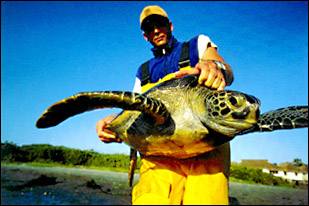Volunteering Your Vacation
Next Time Don't Just Watch the Whales, Study Them
Last year, Muriel Horacek spent two weeks camping in a cave in China as she monitored an endangered species of monkey. She has also radio-tracked cheetahs by airplane over Namibia, taken water samples from a rowboat in a German lake, and in St. Croix caught the eggs of nesting sea turtles in her bare hands. This was all after she turned 70.

The 20 expeditions Horacek has been on over the last six years have been as diverse as the habitats she's visited, but the common thread is Earthwatch, an international nonprofit organization dedicated to joining scientists and ordinary people in building a sustainable future.
Since its inception in 1972, Earthwatch has sponsored more than 2,000 projects in 118 countries and 38 states. The research contributed by its over 50,000 volunteers has resulted in 12 new national parks and reserves, over 2,000 new species discovered, dozens of endangered species rescued from extinction, and health services and sustainable agriculture brought to remote villages in more than 20 countries. The belief that fuels this success, according to Earthwatch president Roger Bergen, is that “almost every problem can be solved with the right blend of expertise and caring, knowledgeable individuals.”
Chipping away at global environmental problems from different angles and disciplines, Earthwatch investigators develop projects in seven research areas: World Oceans, World Forests, Biodiversity, Cultural Diversity, Learning from the Past, Monitoring Global Change, and World Health. Researchers are teamed with people like Horacek, who donate their vacation dollars to work side-by-side with distinguished field scientists. The tax-deductible cost of the one- to four-week expeditions, which range from $695 to nearly $3,000, goes directly to funding the research.
Sheila Chmuhalek, whose research at the University of Manitoba has led to a patent on natural dye extraction and production, previously had the aid of only one graduate student at $8 an hour. Her concern is that “eventually the petroleum industry will be gone and the textile and apparel industries have been very slow to recognize this.” Chmuhalek's project, recently approved for the next field season, will use six teams staggered over the summer to find an ecologically sustainable, non-petroleum based method of coloring clothes.
Dr. Frank Paladino from Indiana-Purdue University, an investigator funded by National Geographic and the National Science Foundation, says those grants have allowed him to actually do the science, but not to pursue it on a long-term basis. For the last 10 years, his Earthwatch-sponsored project on Costa Rican sea turtles has collected nesting data which, when shared with South American officials, resulted in the designation of a new national park.
Paladino's project also piqued the interest of an Earthwatch volunteer, Allison Leslie, who then went on to become his Ph.D. student and return with an Earthwatch project of her own. Leslie's team in St. Lucia National Park, South Africa, researched temperature-dependent sex determination in the declining Nile crocodile population. The team discovered that a foreign plant species shading croc nests actually lowers the incubation temperature, resulting in eggs of only one sex. This may have some far-reaching implications, offering a possible explanation for dinosaur extinction.
Dr. Roger Fouts, author of Next of Kin and renowned primate specialist, hopes to use Earthwatch-generated data to change federal animal welfare regulations, which he says are “not in tune with reality.” Volunteers for his recent project worked with chimps at the University of Washington to determine what combination of elements create the most stimulating captive environment. According to Fouts, “Earthwatch projects are where the rubber meets the road.”
And that road is a windy one. Volunteers may interview poor farmers in the Mississippi River delta, teach Indonesian villagers to cook with a solar oven, or measure the deposition of an Icelandic glacier. At night, they may return to a roaring campfire, a college dorm room, or a condo overlooking the ocean. The tasks and accommodations are as varied as the volunteers themselves, who last year came from 46 countries and all 50 states.
Jennifer Cassidy-Gilbert, an economist from New York City who just went on her first Earthwatch trip, points out that it's easy to live life thinking you can't make a difference. Tracking bottlenose dolphins in Queensland, Australia, she found herself “in absolute paradise…learning how quickly populations can disappear. Earthwatch makes you aware an individual person needs to try and get something done.” She's already planning her next expedition.
After all, as Horacek will testify, “Earthwatch has opened a whole new world for me.”

